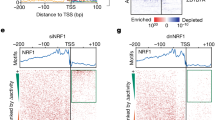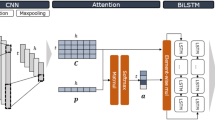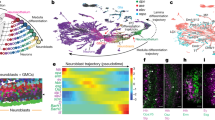Abstract
Transcription factors (TFs) orchestrate gene expression programs crucial for brain function, but we lack detailed information about TF binding in human brain tissue. We generated a multiomic resource (ChIP–seq, ATAC-seq, RNA-seq, DNA methylation) on bulk tissues and sorted nuclei from several postmortem brain regions, including binding maps for more than 100 TFs. We demonstrate improved measurements of TF activity, including motif recognition and gene expression modeling, upon identification and removal of high TF occupancy regions. Further, predictive TF binding models demonstrate a bias for these high-occupancy sites. Neuronal TFs SATB2 and TBR1 bind unique regions depleted for such sites and promote neuronal gene expression. Binding sites for TFs, including TBR1 and PKNOX1, are enriched for risk variants associated with neuropsychiatric disorders, predominantly in neurons. This work, titled BrainTF, is a powerful resource for future studies seeking to understand the roles of specific TFs in regulating gene expression in the human brain.
This is a preview of subscription content, access via your institution
Access options
Access Nature and 54 other Nature Portfolio journals
Get Nature+, our best-value online-access subscription
27,99 € / 30 days
cancel any time
Subscribe to this journal
Receive 12 print issues and online access
209,00 € per year
only 17,42 € per issue
Buy this article
- Purchase on SpringerLink
- Instant access to full article PDF
Prices may be subject to local taxes which are calculated during checkout







Similar content being viewed by others
Data availability
All relevant data generated by this study have been made publicly available through the PsychENCODE Consortium and are available for download at the following link: https://doi.org/10.7303/syn51942384.1. This includes the raw sequencing data (fastq) and processed results that can be used for analyses or visualizations, including bed files of peak calls and bigwigs of signal tracks.
Code availability
The analysis scripts used to generate the images and statistical output in this paper are available on GitHub (https://github.com/aanderson54/Loupe_BrainTF). These scripts use openly accessible packages within the R (v.4.2.2) environment. The associated ‘read.me’ file also provides detailed instructions regarding how to use the provided code.
References
Lambert, S. A. et al. The human transcription factors. Cell 172, 650–665 (2018).
Hammonds, A. S. et al. Spatial expression of transcription factors in Drosophila embryonic organ development. Genome Biol. 14, R140 (2013).
Partridge, E. C. et al. Occupancy maps of 208 chromatin-associated proteins in one human cell type. Nature 583, 720–728 (2020).
Spitz, F. & Furlong, E. E. M. Transcription factors: from enhancer binding to developmental control. Nat. Rev. Genet. 13, 613–626 (2012).
van der Lee, R., Correard, S. & Wasserman, W. W. Deregulated regulators: disease-causing cis variants in transcription factor genes. Trends Genet. 36, 523–539 (2020).
Carrasco Pro, S., Bulekova, K., Gregor, B., Labadorf, A. & Fuxman Bass, J. I. Prediction of genome-wide effects of single nucleotide variants on transcription factor binding. Sci. Rep. 10, 17632 (2020).
Singh, T. et al. Rare coding variants in 10 genes confer substantial risk for schizophrenia. Nature 604, 509–516 (2022).
Ramaker, R. C. et al. Post-mortem molecular profiling of three psychiatric disorders. Genome Med. 9, 72 (2017).
Szczepankiewicz, A. et al. Glucocorticoid receptor polymorphism is associated with major depression and predominance of depression in the course of bipolar disorder. J. Affect. Disord. 134, 138–144 (2011).
Forrest, M. P. et al. The psychiatric risk gene transcription factor 4 (TCF4) regulates neurodevelopmental pathways associated with schizophrenia, autism, and intellectual disability. Schizophr. Bull. 44, 1100–1110 (2018).
Working, S. et al. Biological insights from 108 schizophrenia-associated genetic loci. Nature 511, 421–427 (2014).
Trubetskoy, V. et al. Mapping genomic loci implicates genes and synaptic biology in schizophrenia. Nature 604, 502–508 (2022).
Stefansson, H. et al. Common variants conferring risk of schizophrenia. Nature 460, 744–747 (2009).
Stahl, E. A. et al. Genome-wide association study identifies 30 loci associated with bipolar disorder. Nat. Genet. 51, 793–803 (2019).
Bryois, J. et al. Evaluation of chromatin accessibility in prefrontal cortex of individuals with schizophrenia. Nat. Commun. 9, 3121 (2018).
Fullard, J. F. et al. An atlas of chromatin accessibility in the adult human brain. Genome Res. 28, 1243–1252 (2018).
Bulik-Sullivan, B. et al. An atlas of genetic correlations across human diseases and traits. Nat. Genet. 47, 1236–1241 (2015).
Gandal, M. J., Leppa, V., Won, H., Parikshak, N. N. & Geschwind, D. H. The road to precision psychiatry: translating genetics into disease mechanisms. Nat. Neurosci. 19, 1397–1407 (2016).
van de Geijn, B. et al. Annotations capturing cell type-specific TF binding explain a large fraction of disease heritability. Hum. Mol. Genet. 29, 1057–1067 (2020).
Cross-Disorder Group of the Psychiatric Genomics Consortium. Identification of risk loci with shared effects on five major psychiatric disorders: a genome-wide analysis. Lancet Lond. Engl. 381, 1371–1379 (2013).
PsychENCODE Consortium. et al. The PsychENCODE project. Nat. Neurosci. 18, 1707–1712 (2015).
Fromer, M. et al. Gene expression elucidates functional impact of polygenic risk for schizophrenia. Nat. Neurosci. 19, 1442–1453 (2016).
Girdhar, K. et al. Cell-specific histone modification maps in the human frontal lobe link schizophrenia risk to the neuronal epigenome. Nat. Neurosci. 21, 1126–1136 (2018).
Girdhar, K. et al. Chromatin ___domain alterations linked to 3D genome organization in a large cohort of schizophrenia and bipolar disorder brains. Nat. Neurosci. 25, 474–483 (2022).
The ENCODE Project Consortium. et al. Perspectives on ENCODE. Nature 583, 693–698 (2020).
Haenni, S. et al. Analysis of C. elegans intestinal gene expression and polyadenylation by fluorescence-activated nuclei sorting and 3′-end-seq. Nucleic Acids Res. 40, 6304–6318 (2012).
Dammer, E. B. et al. Neuron enriched nuclear proteome isolated from human brain. J. Proteome Res. 12, 3193–3206 (2013).
Dunham, I. et al. An integrated encyclopedia of DNA elements in the human genome. Nature 489, 57–74 (2012).
The ENCODE Project Consortium. et al. Expanded encyclopaedias of DNA elements in the human and mouse genomes. Nature 583, 699–710 (2020).
McLean, C. Y. et al. GREAT improves functional interpretation of cis-regulatory regions. Nat. Biotechnol. 28, 495–501 (2010).
Gu, Z. & Hübschmann, D. rGREAT: an R/bioconductor package for functional enrichment on genomic regions. Bioinformatics 39, btac745 (2023).
Datta, V., Siddharthan, R. & Krishna, S. Detection of cooperatively bound transcription factor pairs using ChIP–seq peak intensities and expectation maximization. PLoS ONE 13, e0199771 (2018).
Wei, B. et al. A protein activity assay to measure global transcription factor activity reveals determinants of chromatin accessibility. Nat. Biotechnol. 36, 521–529 (2018).
Dobson, T. H. W. et al. Regulation of USP37 expression by REST-associated G9a-dependent histone methylation. Mol. Cancer Res. MCR 15, 1073–1084 (2017).
Mulligan, P. et al. CDYL bridges REST and histone methyltransferases for gene repression and suppression of cellular transformation. Mol. Cell 32, 718–726 (2008).
Hevner, R. F. et al. Tbr1 regulates differentiation of the preplate and layer 6. Neuron 29, 353–366 (2001).
Britanova, O. et al. Satb2 is a postmitotic determinant for upper-layer neuron specification in the neocortex. Neuron 57, 378–392 (2008).
Moffat, J. J. et al. Differential roles of ARID1B in excitatory and inhibitory neural progenitors in the developing cortex. Sci. Rep. 11, 3856 (2021).
Wiegreffe, C. et al. Bcl11a (Ctip1) controls migration of cortical projection neurons through regulation of Sema3c. Neuron 87, 311–325 (2015).
Hao, N., Bhakti, V. L. D., Peet, D. J. & Whitelaw, M. L. Reciprocal regulation of the basic helix-loop-helix/Per-Arnt-Sim partner proteins, Arnt and Arnt2, during neuronal differentiation. Nucleic Acids Res. 41, 5626–5638 (2013).
Latypova, X. et al. Haploinsufficiency of the Sin3/HDAC corepressor complex member SIN3B causes a syndromic intellectual disability/autism spectrum disorder. Am. J. Hum. Genet. 108, 929–941 (2021).
Wreczycka, K. et al. HOT or not: examining the basis of high-occupancy target regions. Nucleic Acids Res. 47, 5735–5745 (2019).
Kvon, E. Z., Stampfel, G., Yáñez-Cuna, J. O., Dickson, B. J. & Stark, A. HOT regions function as patterned developmental enhancers and have a distinct cis-regulatory signature. Genes Dev. 26, 908–913 (2012).
Gerstein, M. B. et al. Integrative analysis of the Caenorhabditis elegans genome by the modENCODE project. Science 330, 1775–1787 (2010).
Moorman, C. et al. Hotspots of transcription factor colocalization in the genome of Drosophila melanogaster. Proc. Natl Acad. Sci. USA 103, 12027–12032 (2006).
Castro-Mondragon, J. A. et al. JASPAR 2022: the 9th release of the open-access database of transcription factor binding profiles. Nucleic Acids Res. 50, D165–D173 (2022).
Worsley Hunt, R. & Wasserman, W. W. Non-targeted transcription factors motifs are a systemic component of ChIP–seq datasets. Genome Biol. 15, 412 (2014).
Bailey, T. L., Johnson, J., Grant, C. E. & Noble, W. S. The MEME suite. Nucleic Acids Res. 43, W39–W49 (2015).
McGann, J. C. et al. The genome-wide binding profile for human RE1 silencing transcription factor unveils a unique genetic circuitry in hippocampus. J. Neurosci. 41, 6582–6595 (2021).
Vierstra, J. et al. Global reference mapping of human transcription factor footprints. Nature 583, 729–736 (2020).
Long, Y.-S. et al. Human transcription factor genes involved in neuronal development tend to have high GC content and CpG elements in the proximal promoter region. J. Genet. Genomics Yi Chuan Xue Bao 38, 157–163 (2011).
Mao, X., Yang, S.-H., Simpkins, J. W. & Barger, S. W. Glutamate receptor activation evokes calpain-mediated degradation of Sp3 and Sp4, the prominent Sp-family transcription factors in neurons. J. Neurochem. 100, 1300–1314 (2007).
Kiyama, T. et al. Essential roles of mitochondrial biogenesis regulator Nrf1 in retinal development and homeostasis. Mol. Neurodegener. 13, 56 (2018).
Dejosez, M. et al. Regulatory architecture of housekeeping genes is driven by promoter assemblies. Cell Rep. 42, 112505 (2023).
Karimzadeh, M. & Hoffman, M. M. Virtual ChIP–seq: predicting transcription factor binding by learning from the transcriptome. Genome Biol. 23, 126 (2022).
Barretina, J. et al. The Cancer Cell Line Encyclopedia enables predictive modelling of anticancer drug sensitivity. Nature 483, 603–607 (2012).
Xu, Q. et al. ANANSE: an enhancer network-based computational approach for predicting key transcription factors in cell fate determination. Nucleic Acids Res. 49, 7966–7985 (2021).
Anderson, A. G. et al. Single nucleus multiomics identifies ZEB1 and MAFB as candidate regulators of Alzheimer’s disease-specific cis-regulatory elements. Cell Genom. 3, 100263 (2023).
Chen, X. et al. Structural insights into preinitiation complex assembly on core promoters. Science 372, eaba8490 (2021).
Vaquero, A. et al. Human SirT1 interacts with histone H1 and promotes formation of facultative heterochromatin. Mol. Cell 16, 93–105 (2004).
Han, W. et al. TBR1 directly represses Fezf2 to control the laminar origin and development of the corticospinal tract. Proc. Natl Acad. Sci. USA 108, 3041–3046 (2011).
Wang, L. et al. The zinc finger transcription factor Zbtb7b represses CD8-lineage gene expression in peripheral CD4+ T cells. Immunity 29, 876–887 (2008).
Li, S. et al. Zbtb7b engages the long noncoding RNA Blnc1 to drive brown and beige fat development and thermogenesis. Proc. Natl Acad. Sci. USA 114, E7111–E7120 (2017).
Finucane, H. K. et al. Partitioning heritability by functional annotation using genome-wide association summary statistics. Nat. Genet. 47, 1228–1235 (2015).
Managò, F. & Papaleo, F. Schizophrenia: what’s Arc got to do with It? Front. Behav. Neurosci. 11, 181 (2017).
Zhang, W. et al. Structural basis of arc binding to synaptic proteins: implications for cognitive disease. Neuron 86, 490–500 (2015).
Lanoue, V. et al. The adhesion-GPCR BAI3, a gene linked to psychiatric disorders, regulates dendrite morphogenesis in neurons. Mol. Psychiatry 18, 943–950 (2013).
Amemiya, H. M., Kundaje, A. & Boyle, A. P. The ENCODE Blacklist: identification of problematic regions of the genome. Sci. Rep. 9, 9354 (2019).
Bellenguez, C. et al. New insights into the genetic etiology of Alzheimer’s disease and related dementias. Nat. Genet. 54, 412–436 (2022).
Hass, J. et al. Associations between DNA methylation and schizophrenia-related intermediate phenotypes a gene set enrichment analysis. Prog. Neuropsychopharmacol. Biol. Psychiatry 59, 31–39 (2015).
Ohayon, S., Yitzhaky, A. & Hertzberg, L. Gene expression meta-analysis reveals the up-regulation of CREB1 and CREBBP in Brodmann Area 10 of patients with schizophrenia. Psychiatry Res. 292, 113311 (2020).
Liu, S. et al. The early growth response protein 1-miR-30a-5p-neurogenic differentiation factor 1 axis as a novel biomarker for schizophrenia diagnosis and treatment monitoring. Transl. Psychiatry 7, e998 (2017).
Nalls, M. A. et al. Identification of novel risk loci, causal insights, and heritable risk for Parkinson’s disease: a meta-analysis of genome-wide association studies. Lancet Neurol. 18, 1091–1102 (2019).
van Rheenan, W. et al. Common and rare variant association analyses in amyotrophic lateral sclerosis identify 15 risk loci with distinct genetic architectures and neuron-specific biology. Nat. Genet. 53, 1636–1648 (2021).
Ruderfer, D. M. et al. Genomic dissection of bipolar disorder and schizophrenia, including 28 subphenotypes. Cell 173, 1705–1715.e16 (2018).
Nagel, M. et al. Meta-analysis of genome-wide association studies for neuroticism in 449,484 individuals identifies novel genetic loci and pathways. Nat. Genet. 50, 920–927 (2018).
Demontis, D. et al. Discovery of the first genome-wide significant risk loci for attention deficit/hyperactivity disorder. Nat. Genet. 51, 63–75 (2019).
Grove, J. et al. Identification of common genetic risk variants for autism spectrum disorder. Nat. Genet. 51, 431–444 (2019).
Wray, N. R. et al. Genome-wide association analyses identify 44 risk variants and refine the genetic architecture of major depression. Nat. Genet. 50, 668–681 (2018).
Liu, J. Z. et al. Association analyses identify 38 susceptibility loci for inflammatory bowel disease and highlight shared genetic risk across populations. Nat. Genet. 47, 979–986 (2015).
Okada, Y. et al. Genetics of rheumatoid arthritis contributes to biology and drug discovery. Nature 506, 376–381 (2014).
Julià, A. et al. Genome-wide association study meta-analysis identifies five new loci for systemic lupus erythematosus. Arthritis Res. Ther. 20, 100 (2018).
Locke, A. E. et al. Genetic studies of body mass index yield new insights for obesity biology. Nature 518, 197–206 (2015).
Wood, A. R. et al. Defining the role of common variation in the genomic and biological architecture of adult human height. Nat. Genet. 46, 1173–1186 (2014).
Savic, D., Gertz, J., Cooper, G. M. & Myers, R. M. Mapping genome-wide transcription factor binding sites in frozen tissues. Epigenetics Chromatin 6, 30 (2013).
Jiang, Y., Matevossian, A., Huang, H.-S., Straubhaar, J. & Akbarian, S. Isolation of neuronal chromatin from brain tissue. BMC Neurosci. 9, 42 (2008).
Reddy, T. E. et al. Genomic determination of the glucocorticoid response reveals unexpected mechanisms of gene regulation. Genome Res. 19, 2163–2171 (2009).
Martin, M. Cutadapt removes adapter sequences from high-throughput sequencing reads. EMBnet. J. 17, 10–12 (2011).
Landt, S. G. et al. ChIP-seq guidelines and practices of the ENCODE and modENCODE consortia. Genome Res. 22, 1813–1831 (2012).
Krueger, F. & Andrews, S. R. Bismark: a flexible aligner and methylation caller for bisulfite-seq applications. Bioinformatics 27, 1571–1572 (2011).
Buenrostro, J. D., Giresi, P. G., Zaba, L. C., Chang, H. Y. & Greenleaf, W. J. Transposition of native chromatin for fast and sensitive epigenomic profiling of open chromatin, DNA-binding proteins and nucleosome position. Nat. Methods 10, 1213–1218 (2013).
Buenrostro, J. D., Wu, B., Chang, H. Y. & Greenleaf, W. J. ATAC-seq: a method for assaying chromatin accessibility genome-wide. Curr. Protoc. Mol. Biol. 2015, 21.29.1–21.29.9 (2015).
Corces, M. R. An improved ATAC-seq protocol reduces background and enables interrogation of frozen tissues. Nat. Methods 176, 139–148 (2017).
Weirauch, M. T. et al. Determination and inference of eukaryotic transcription factor sequence specificity. Cell 158, 1431–1443 (2014).
Acknowledgements
We thank the brain donors and their families, without whom this research would not have been possible. This study was supported by National Institutes of Health grant 5R01MH110472 awarded to R.M.M. and G.M.C., the Memory and Mobility Fund from HudsonAlpha Institute for Biotechnology and support from the Pritzker Neuropsychiatric Research Consortium. The funders had no role in study design, data collection and analysis, decision to publish or preparation of the manuscript.
Author information
Authors and Affiliations
Contributions
R.M.M., G.M.C. and J.M.L. conceptualized the study. J.M.L., L.F.R., I.R.-N., K.T.-L. and R.J. performed the investigation. J.M.L., L.F.R. and A.G.A. curated the data. J.M.L., A.G.A., B.M. and I.R.-N. performed the formal analysis. W.E.B., B.G.B., P.C., A.S., S.J.W. and H.A. provided brain tissue and resources. J.M.L. wrote the original draft of the manuscript. R.M.M. and G.M.C. acquired funding.
Corresponding authors
Ethics declarations
Competing interests
The authors declare no competing interests.
Peer review
Peer review information
Nature Neuroscience thanks Stella Dracheva and the other, anonymous, reviewer(s) for their contribution to the peer review of this work.
Additional information
Publisher’s note Springer Nature remains neutral with regard to jurisdictional claims in published maps and institutional affiliations.
Supplementary information
Supplementary Information
Supplementary Figs. 1–14.
Supplementary Table 1
Postmortem metadata.
Supplementary Table 2
Experiment list and quality control.
Supplementary Table 3
Antibodies for ChIP–seq.
Supplementary Table 4
ChIP–seq peak unions.
Supplementary Table 5
GREAT pathways enrichment.
Supplementary Table 6
HOT skewness values.
Supplementary Table 7
motifmatchR results.
Supplementary Table 8
Motif calling MEME.
Supplementary Table 9
Virtual ChIP–seq.
Supplementary Table 10
Partitioned heritability.
Supplementary Table 11
Statistics.
Rights and permissions
Springer Nature or its licensor (e.g. a society or other partner) holds exclusive rights to this article under a publishing agreement with the author(s) or other rightsholder(s); author self-archiving of the accepted manuscript version of this article is solely governed by the terms of such publishing agreement and applicable law.
About this article
Cite this article
Loupe, J.M., Anderson, A.G., Rizzardi, L.F. et al. Multiomic profiling of transcription factor binding and function in human brain. Nat Neurosci 27, 1387–1399 (2024). https://doi.org/10.1038/s41593-024-01658-8
Received:
Accepted:
Published:
Issue Date:
DOI: https://doi.org/10.1038/s41593-024-01658-8



